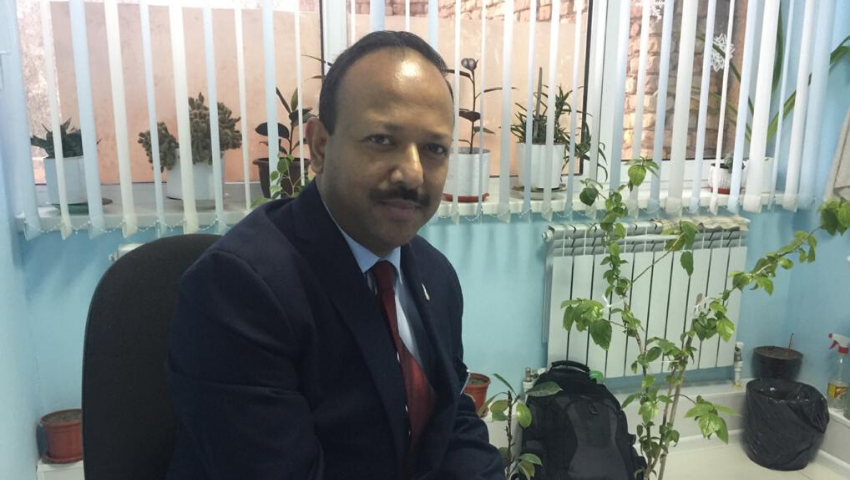Coronary artery bypass surgery (also called coronary artery bypass grafting or CABG) is a treatment for patients with a blockage in the heart arteries. Coronary artery disease is narrowing or blockage of one or more of the coronary arteries that supply oxygen-rich blood to the heart. Most commonly, a bypass operation is performed when multiple heart arteries show very critical blockage.
Coronary artery bypass surgery restores normal blood flow to the heart by creating an alternate route(bypass) around the blocked artery/arteries. This is done by using a healthy blood vessel, called a graft. Grafts usually come from your own arteries and veins located in the chest, leg or arm. The graft creates a new pathway to carry oxygen-rich blood to the heart.
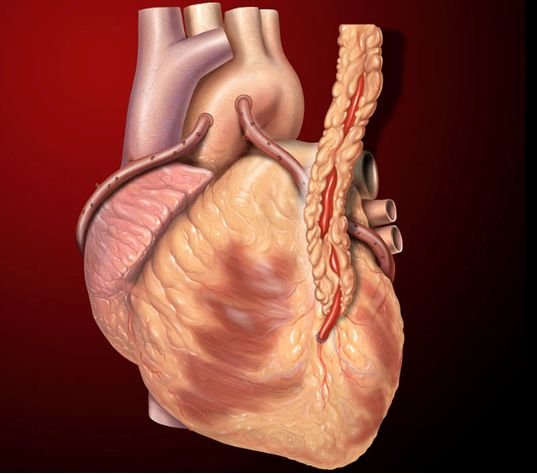
A bypass operation is done mainly to improve or preserve your heart function, usually called the ejection fraction. It mainly helps:
- To relieve your symptoms of angina( Chest pain), difficulty in breathing, Palpitations or Ghabrahat or chest discomfort.
- To improve your quality of life, so that you can live a healthy life and can resume your normal activities.
- To increase your lifespan (it's now proven that bypass operation patients live much longer than patients who are taking only tablets).
- Most importantly, to prevent death from a future heart attack.
Off-Pump CABG or BEATING HEART BYPASS: In this technique, the heart keeps beating, while the surgeon stabilises the heart with a device called stabiliser and then performs the bypass grafts. This technique is physiological and in selected cases reduce many complications.
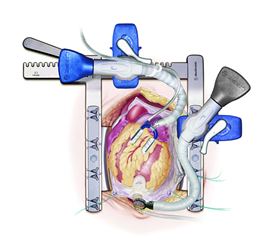
On Pump CABG – In this technique, you will be connected to a machine called the “heart-lung machine” and your heart will be stopped and then the surgeon performs the bypass grafts.
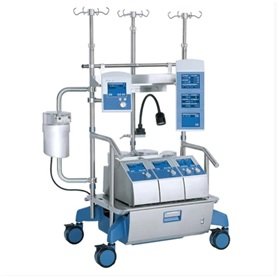
The technique of bypass operation, whether off-pump or on-pump will be decided by your surgeon after going through all your reports. By and large, most of the bypasses done are usually off-pump or the “Beating Heart” technique.
Single bypass means only one of your heart arteries is bypassed, while in double, triple or quadruple bypasses two, three or four of your heart arteries are bypassed. As mentioned, these are created by vessels from your own body, usually left internal mammary artery from your chest wall or your own leg veins or the forearm artery.
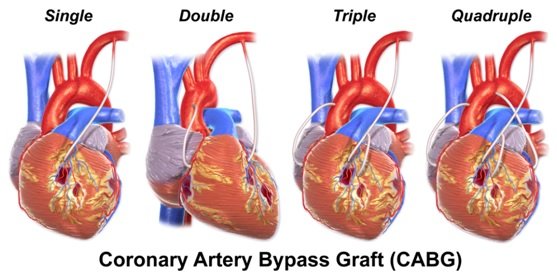
Bypass surgery is always done under General anaesthesia and you are usually admitted a day prior to the day of the operation. Cardiothoracic Surgeon will usually order all the tests needed to see your fitness like blood tests, urine tests, your diabetic state, ECG, Echocardiogram and would also consult relevant specialists to make sure that you are fully fit to go through the procedure.
Our physiotherapists will also train you regarding all the necessary cardiopulmonary exercises needed after surgery during your recovery phase. Our Anesthesia doctor will examine you for a detailed pre-anaesthetic check-up and sort out any medical condition that may need attention and correction.
You will be wheeled into the cardiac operating room recovery area where the surgical and anaesthesia team will perform a final checklist of all the protocols and then you will be taken inside the operation room. Inside the operation theatre, the anaesthesia doctor may place a small needle with a catheter in your backbone area, also called a Thoracic Epidural catheter. This catheter will make your entire stay completely pain free. Following this, you will be put into a deep sleep and then the main operation would begin.
Usually, two teams work at the same time – one team usually works on the leg part and the other team works on the chest part. Usually, the best bone will be divided in the midline to access the heart but nowadays, a good number of bypass operations are done without opening the breast bone and this procedure is called “keyhole” or MIDCAB operation.
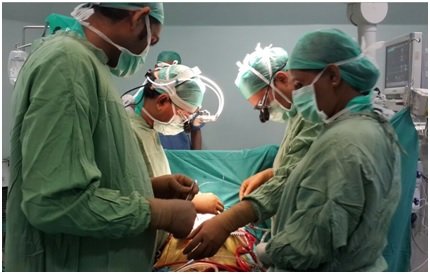
Usually, there will be a scar in the mid part of your chest over your breast bone also called the “sternum” and another scar either on your leg, forearm or thigh depending on what grafts was used in your case. The size of the cut depends on the technique of the surgery.
For a usual bypass, the cut will be in the front part of your chest, but for keyhole surgery, the cut will be on the side of your chest just below the nipple. Moreover, if we use Endoscopic techniques, then the size of the scar on the leg or hand will be barely visible. Lastly, if the surgeon decides to do a total arterial bypass, then you will have only one scar in the front of your chest.
Most commonly, the left internal mammary artery from the chest wall and saphenous veins from legs are used as popular grafts in bypass operation worldwide. The other grafts include radial artery from the hand, Gastroepiploic artery from the tummy and of course the right internal mammary artery. The surgical team will decide about the best grafting for you depending on various parameters.
It again depends on the nature of the blockages in your arteries, but, most commonly you will either have three (called Triple ) or four (called quadruple ) bypasses. Some patients may need an even higher number of grafts if the disease is very severe.
Usually, it varies from 5-6 days in the hospital wherein, you will be in the cardiac intensive care unit for a day or two and then in the room for about 2-3 days.
Inside the hospital, we will take you through a complete and comprehensive cardiac rehabilitation programme. This comprises of your cardiopulmonary exercises, walking, going back to normal physical activities and of course care of your operative wounds. You and your family will also be briefed by an expert cardiac dietician about a healthy heart diet. You will be made completely independent before getting out of the hospital.
Bypass operation gives an excellent long term outcome to the extent of 20 years after the first operation. However, its necessery to maintain regular follow up with your surgeon, remain very active and eat healthy diet to have the best of the long term outcomes
Usually, it takes 2 months time for the complete recovery from the surgery. However, we encourage people to start going out from 3 weeks onwards and join offices by the end of 4th week. Early resumption of normal life depends on a good rehabilitation programme. You can start driving by the end of 6th Week and start swimming and gymnasium from 8th week onwards. Sexual life can be resumed from 4th week onwards after consulting your surgeon.
It usually takes about 3 months for a complete recovery from a bypass operation and usually 2 months from a keyhole bypass operation. However, most of the people can start to work within a month from the day of his/her operation depending on the level of activity required. There are general rules to be followed for a successful recovery after a bypass operation and its mandatory to go through these guidelines:
- ESTABLISH A DAILY ROUTINE: Try to establish a very healthy routine - waking up and going to bed at the same time of the day, timely medications, regular meals according to the diet charts and daily bath and enjoy the regular hobbies like listening to music, reading a newspaper or watching your favourite channel on television.
- Do ATTEND YOUR CARDIAC REHABILITATION: Its very essential to attend to your cardiac rehabilitation programme regularly for early recovery and for the early return of your routine activities.
- DO TAKE YOUR MEDICATIONS ON TIME - Schedule your regular medication timing as per your daily meal schedule and never miss any tablets, especially the pain medications- so that you are pain-free all the time.
- DO YOUR CARDIOPULMONARY EXERCISES and Passive Limb exercises DAILY
- DO TAKE SHOWER DAILY: Take a shower regularly after all your dressings are over with soap and water and always wear clean and dry cloths.
- 6. DO ASK FOR HELP: Always ask for help when its required - like for getting up from bed or for climbing stairs or going to the toilet or in taking a shower.
- Don’t smoke
- Don’t drink alcohol within 6 weeks of your surgery
- Don’t lift heavy objects
- Don’t drive a bike or kick start a bike or scooter within 6 weeks
- Don’t sleep on sides for at least 6 weeks of surgery
- Don’t take excessive meat and fluids in the first 4 weeks
Usually, a standard bypass operation carries a 1% risk of something going wrong with you. The usual problems following a heart bypass operation include bleeding, pneumonia, infection, problems in your kidneys or brain (temporary). Most of these issues are usually managed with medications by the relevant experts.
Usually, a standard bypass operation carries a 1% risk of something going wrong with you. The usual problems following a heart bypass operation include bleeding, pneumonia, infection, problems in your kidneys or brain (temporary). Most of these issues are usually managed with medications by the relevant experts.
Most of the bypass operations are done in the age group of 60 to 7o years. However, off late, it been commonly being done for patients aged between 70 to 80 years and even beyond. It all depends on the physical fitness and the social support from family and usually needs a very aggressive cardiac rehabilitation program.
Usually, a standard bypass operation carries a 1% risk of something going wrong with you. The usual problems following a heart bypass operation include bleeding, pneumonia, infection, problems in your kidneys or brain (temporary). Most of these issues are usually managed with medications by the relevant experts.
- Shortness of breath (can happen usually due to low Haemoglobin in your body, less food intake, ingestion of urine tablets called diuretics)
- Loss of appetite- usually due to loss of taste due to the usage of antibiotics
- Pain in the throat – maybe because of the throat tube placed during surgery (usually temporary)
- Feeling depressed – very usual and very short-lasting
- Numbness along the skin incision in the chest – temporary and fade away in a few days
- Sleeplessness- usually due to stay in the hospital
- Mild pain in the chest – not to panic (its usually from the scar) and not heart attack again
- Some swelling of the legs and the hands( very common and usually
fades away in few days)
- Irregular bowel habits
- Excessive pain and redness around the scars
- Continuous high-grade Fever with temperature more than 100 degrees Of Fahrenheit
- Pus coming out of your scars
- Excessive vomiting
- Unusual difficulty in breathing with the inability to lie down
- Getting blackouts
- Fast heartbeats called palpitations
- Less amount of Urine
The type of incision you have depends on the type of heart surgery you had:
- If you had a traditional sternal incision, your surgeon used sternal wires to close your breastbone, and your chest incision was closed with internal or external stitches.
- If you had minimally invasive surgery, you likely have a much smaller incision that may or may not have gone through your sternum. You may also have small incisions on your groin, leg or arm, as well as small wounds from chest tubes, pacemaker wires or intravenous (IV) lines.
Inspect all your incisions and wounds every day for signs of infection. Call your doctor or our Heart and Vascular Institute post discharge nurse line if you see:
- Increased drainage or oozing from the incision.
- Increased opening of the incision line.
- Redness around the incision.
- Warmth along the incision line.
- Fever (greater than 101 degrees Fahrenheit or 38.4 degrees Celsius).
- If you have diabetes and your blood sugar levels begin to vary more than usual.
Wash your hands before and after caring for or touching your incision. Keep your incision(s) clean and dry.
You do not need to cover your wound with a bandage unless there is drainage. If you have drainage, it is important to call your doctor.
Showering and Bathing
If your chest incision is healing and there is no drainage – it is ok to take a quick shower (no longer than 10 minutes). If you have stitches in your chest, during the first two weeks after surgery, shower with your back to the shower spray. It is okay for your incision to get wet, but the shower spray should not directly hit your chest.
If you do not have a shower, you may take a quick bath (no longer than 10 minutes). Do not soak in the tub. The water temperature should be warm — not too hot or cold. Extreme water temperatures can cause you to feel faint. It is ok to wash your incision when you shower or bathe, however only use soap and water to cleanse the site.
- Use normal bar soap, not perfumed soap or body wash. Don’t try a new brand of soap during your recovery.
- Place soapy water on your hand or washcloth and gently wash your incision(s) using an up-and-down motion.
- Do not apply ointments, oils, salves or dressings to your incision unless specifically told to do so.
- Pat the skin gently to dry.
It all depends on your medical condition. In general, it's better to avoid alcohol within the first three months of your bypass operation. After 3 months, a mild intake of alcohol may be allowed with strict supervision from your surgeon. Usually, 30-45 ml of spirits (like Whiskey, Vodka) or 350 ml of Beer or 120 ml Of Red wine twice in a week may be considered safe drinking. However, if possible, you should avoid consuming alcohol as much as possible.
From a large number of scientific research, it's now proved that the usual life of a cardiac bypass operation extends easily beyond 20 years. However, the life of this operation largely depends on lifestyle, regular follow up with surgeons, control of diabetes and maintaining a very active life.




